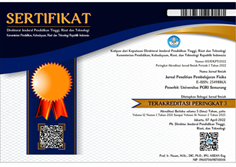Implementation of DenseNet121 Architecture for Waste Type Classification
DOI:
https://doi.org/10.26877/asset.v6i3.673Keywords:
Waste, Classification, DenseNet, Deep LearningAbstract
The growing waste management problem in many parts of the world requires innovative solutions to ensure efficiency in sorting and recycling. One of the main challenges is accurate waste classification, which is often hampered by the variability in visual characteristics between waste types. As a solution, this research develops an image-based litter classification model using Deep Learning DenseNet architecture. The model is designed to address the need for automated waste sorting by classifying waste into ten different categories, using diverse training datasets. The results of this study showed that the model achieved an overall accuracy rate of 93%, with an excellent ability to identify and classify specific materials such as batteries, biological materials, and brown glass. Despite some challenges in metal and plastic classification, these results confirm the great potential of using Deep Learning technology in waste management systems to improve sorting processes and increase recycling efficiency
References
E. Nofiyanti et al., “JAMAIKA: Jurnal Abdi Masyarakat Program Studi Teknik Informatika Universitas Pamulang, Pelatihan Daur Ulang Sampah Plastik Menjadi Souvenir Ramah Lingkungan Di Kabupaten Tasikmalaya,” Jurnal Abdi Masyarakat , vol. 1, no. 2, 2020.
C. Janiesch, P. Zschech, and K. Heinrich, “Machine learning and deep learning,” Electronic Markets, vol. 31, no. 3, 2021, doi: 10.1007/s12525-021-00475-2.
Ulfah Nur Oktaviana and Yufis Azhar, “Garbage Classification Using Ensemble DenseNet169,” Jurnal RESTI (Rekayasa Sistem dan Teknologi Informasi), vol. 5, no. 6, pp. 1207–1215, Dec. 2021, doi: 10.29207/resti.v5i6.3673.
L. Liu et al., “Deep Learning for Generic Object Detection: A Survey,” Int J Comput Vis, vol. 128, no. 2, 2020, doi: 10.1007/s11263-019-01247-4.
M. R. S. Alfarizi, M. Z. Al-farish, M. Taufiqurrahman, G. Ardiansah, and M. Elgar, “Penggunaan Python Sebagai Bahasa Pemrograman untuk Machine Learning dan Deep Learning,” Karya Ilmiah Mahasiswa Bertauhid (KARIMAH TAUHID), vol. 2, no. 1, 2023.
Z. G. Al-Mekhlafi et al., “Deep Learning and Machine Learning for Early Detection of Stroke and Haemorrhage,” Computers, Materials and Continua, vol. 72, no. 1, 2022, doi: 10.32604/cmc.2022.024492.
D. D. Affifah, Y. Permanasari, and R. Respitawulan, “Teknik Konvolusi pada Deep Learning untuk Image Processing,” Bandung Conference Series: Mathematics, vol. 2, no. 2, 2022.
L. Anggraini Susanti, A. M. Soleh, B. Sartono, I. Pertanian Bogor, and P. Korespondensi, “Deep Learning Image Classification Rontgen Dada Pada Kasus Covid-19 Menggunakan Algoritma Convolutional Neural Network,” Jurnal Teknologi Informasi dan Ilmu Komputer (JTIIK), vol. 10, pp. 973–982, 2023, doi: 10.25126/jtiik.2023107142.
M. C. Wujaya and L. W. Santoso, “Klasifikasi Pakaian Berdasarkan Gambar Menggunakan Metode YOLOv3 dan CNN,” 2021.
R. H. Alfikri, M. S. Utomo, H. Februariyanti, and E. Nurwahyudi, “Pembangunan Aplikasi Penerjemah Bahasa Isyarat Dengan Metode CNN Berbasis Android,” Jurnal Teknoinfo, vol. 16, no. 2, 2022, doi: 10.33365/jti.v16i2.1752.
A. D. Saputra, D. Hindarto, and H. Santoso, “Disease Classification on Rice Leaves using DenseNet121, DenseNet169, DenseNet201,” Sinkron, vol. 8, no. 1, pp. 48–55, Jan. 2023, doi: 10.33395/sinkron.v8i1.11906.
T. Liao et al., “Classification of asymmetry in mammography via the DenseNet convolutional neural network,” European Journal of Radiology Open, vol. 11. Elsevier Ltd, Dec. 01, 2023. doi: 10.1016/j.ejro.2023.100502.
A. M. Simarmata, P. Salim, N. J. Waruwu, and J. Jessica, “Densenet Architecture Implementation for Organic and Non-Organic Waste,” sinkron, vol. 8, no. 4, pp. 2444–2449, Oct. 2023, doi: 10.33395/sinkron.v8i4.12765.
A. Sajwan and G. Mishra, “Comparative Analysis of ResNet and DenseNet for Differential Cryptanalysis of SPECK 32/64 Lightweight Block Cipher,” in Cryptology and Network Security with Machine Learning, A. Chaturvedi, S. U. Hasan, B. K. Roy, and B. Tsaban, Eds., Singapore: Springer Nature Singapore, 2024, pp. 495–504.
L. Yin, P. Hong, G. Zheng, H. Chen, and W. Deng, “A Novel Image Recognition Method Based on DenseNet and DPRN,” Applied Sciences (Switzerland), vol. 12, no. 9, May 2022, doi: 10.3390/app12094232.
K. C. Pavithra, P. Kumar, M. Geetha, and S. V. Bhandary, “Comparative Analysis of Pre-trained ResNet and DenseNet Models for the Detection of Diabetic Macular Edema,” in Journal of Physics: Conference Series, Institute of Physics, 2023. doi: 10.1088/1742-6596/2571/1/012006.
F. P. Fantara, D. Syauqy, and G. E. Setyawan, “Implementasi Sistem Klasifikasi Sampah Organik dan Anorganik dengan Metode Jaringan Saraf Tiruan Backpropagation,” Jurnal Pengembangan Teknologi Informasi dan Ilmu Komputer, vol. 2, no. 11, pp. 5577–5586, Nov. 2018.
N. N. Prakash, V. Rajesh, D. L. Namakhwa, S. Dwarkanath Pande, and S. H. Ahammad, “A DenseNet CNN-based liver lesion prediction and classification for future medical diagnosis,” Sci Afr, vol. 20, Jul. 2023, doi: 10.1016/j.sciaf.2023.e01629.
Z. Zhong, M. Zheng, H. Mai, J. Zhao, and X. Liu, “Cancer image classification based on DenseNet model,” in Journal of Physics: Conference Series, IOP Publishing Ltd, Nov. 2020. doi: 10.1088/1742-6596/1651/1/012143.
G. Wang, Z. Guo, X. Wan, and X. Zheng, “Study on Image Classification Algorithm Based on Improved DenseNet,” in Journal of Physics: Conference Series, IOP Publishing Ltd, Jun. 2021. doi: 10.1088/1742-6596/1952/2/022011.
Y. Hou, Z. Wu, X. Cai, and T. Zhu, “The application of improved densenet algorithm in accurate image recognition,” Sci Rep, vol. 14, no. 1, Dec. 2024, doi: 10.1038/s41598-024-58421-z.
S. Solihat, S. Widodo, and D. P. Sari, “Jurnal Media Informatika Budidarma, Analisis Perbandingan Optimizer pada Pelatihan Model Convolutional Neural Network untuk Kasus Klasifikasi Hewan Primata,” Jurnal Media Informatika Budidarma, vol. 8, no. 1, pp. 454–467, 2024, doi: 10.30865/mib.v8i1.7274.
J. Xu, Y. Zhang, and D. Miao, “Three-way confusion matrix for classification: A measure driven view,” Inf Sci (N Y), vol. 507, 2020, doi: 10.1016/j.ins.2019.06.064.
B. P. Pratiwi, A. S. Handayani, and S. Sarjana, “Pengukuran Kinerja Sistem Kualitas Udara Dengan Teknologi WSN Menggunakan Confusion Matrix,” Jurnal Informatika Upgris, vol. 6, no. 2, 2021, doi: 10.26877/jiu.v6i2.6552.
S. Visa, B. Ramsay, A. Ralescu, and E. Van Der Knaap, “Confusion Matrix-based Feature Selection. Confusion Matrix-based Feature Selection,” 2011. [Online]. Available: https://www.researchgate.net/publication/220833270











